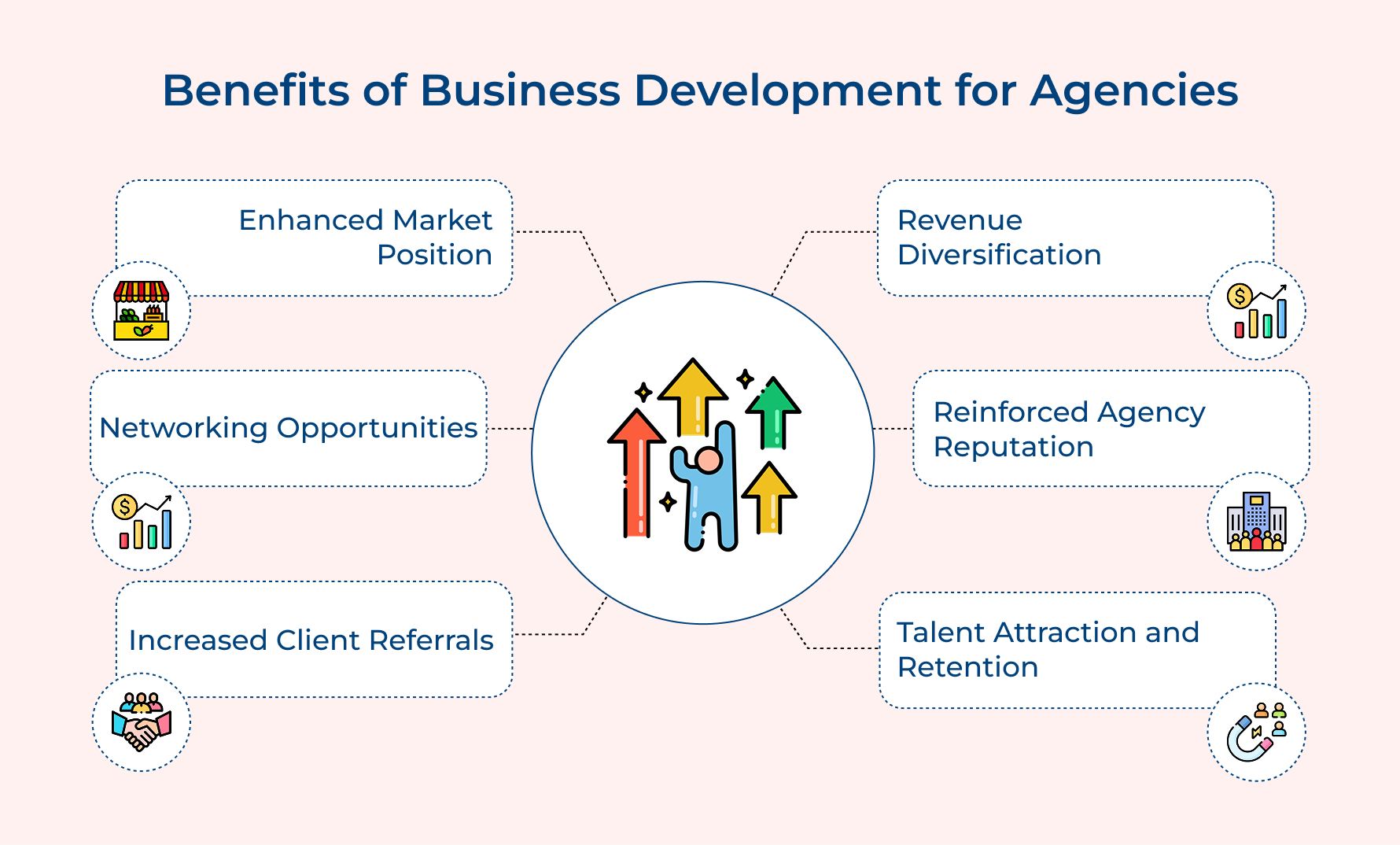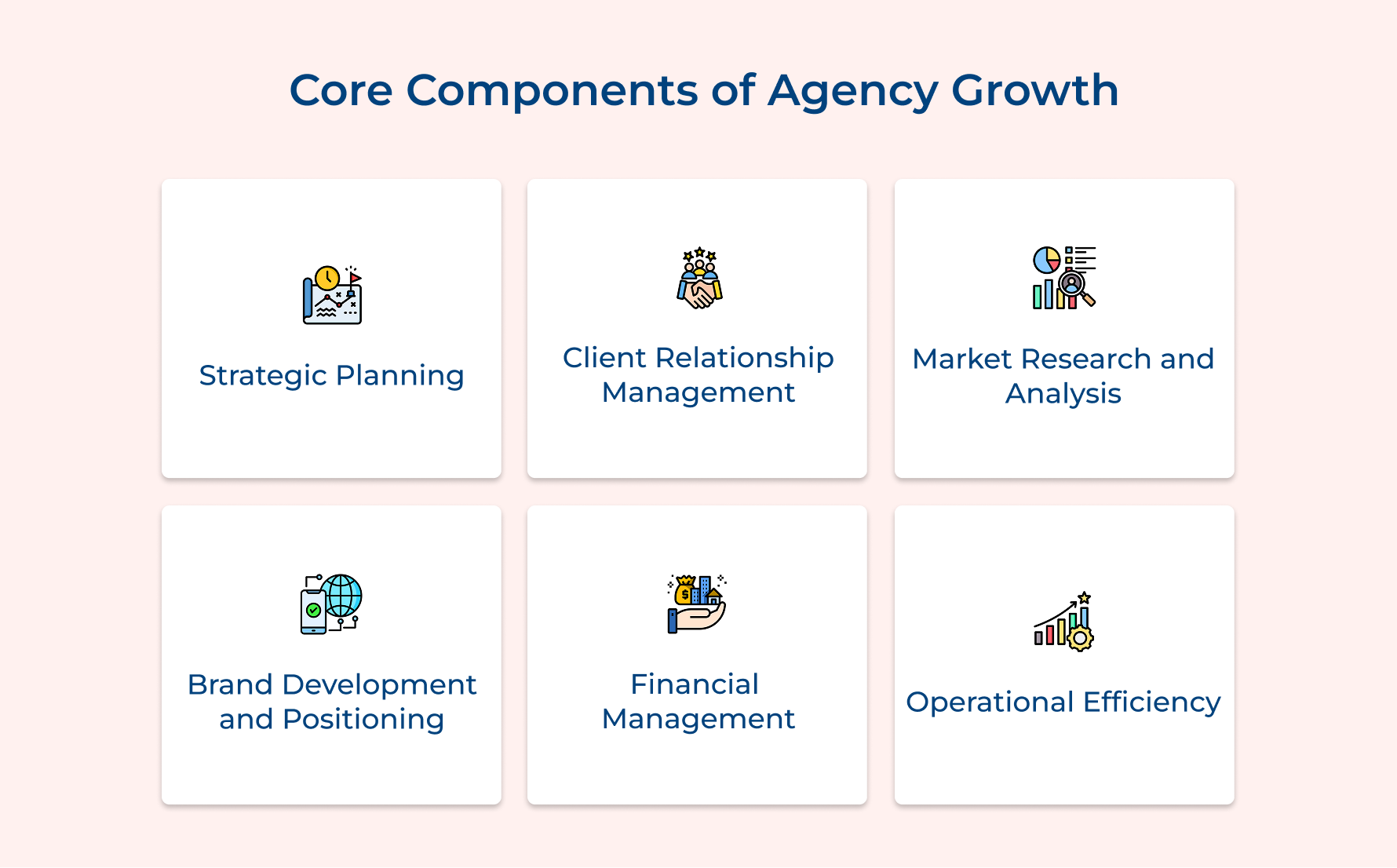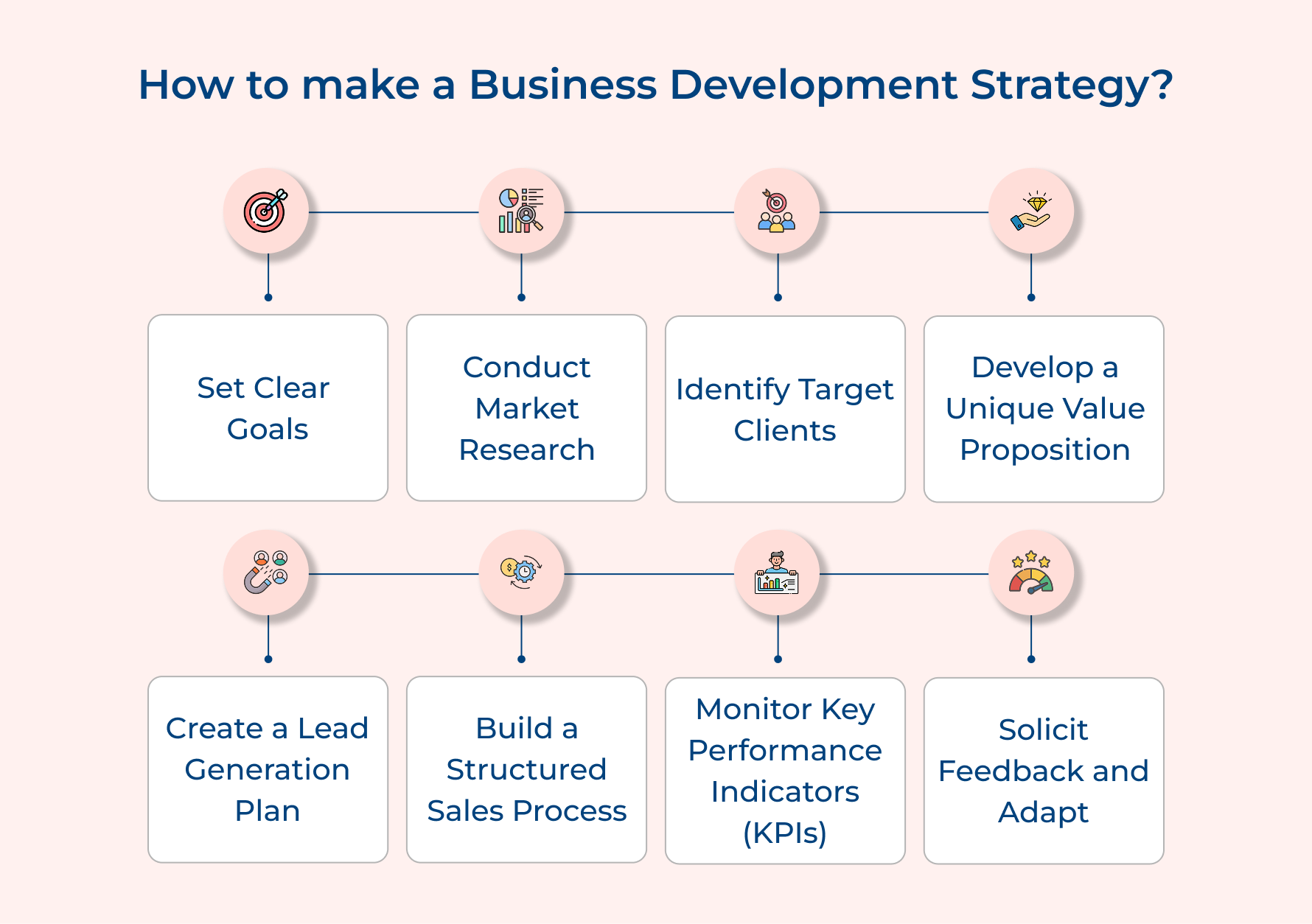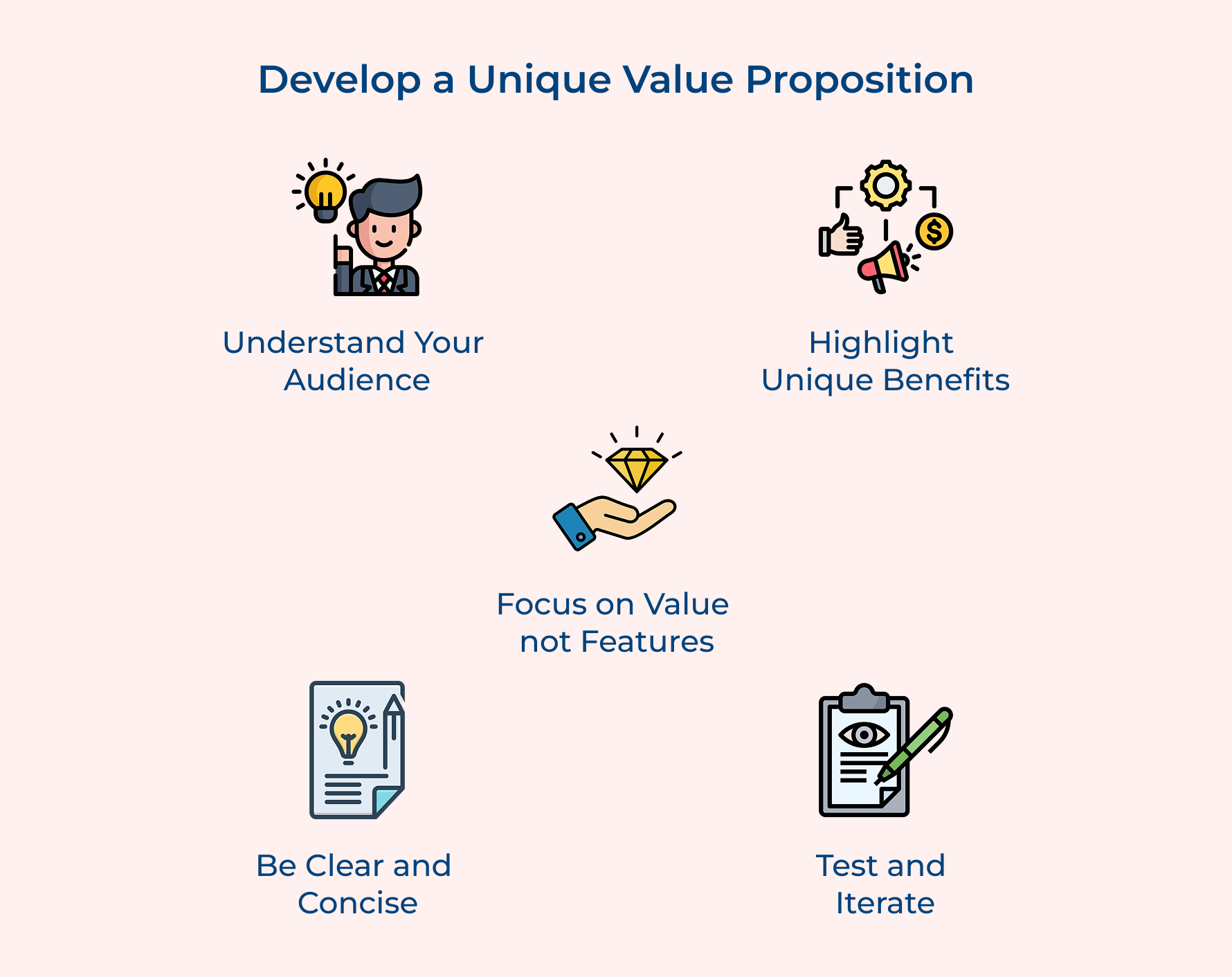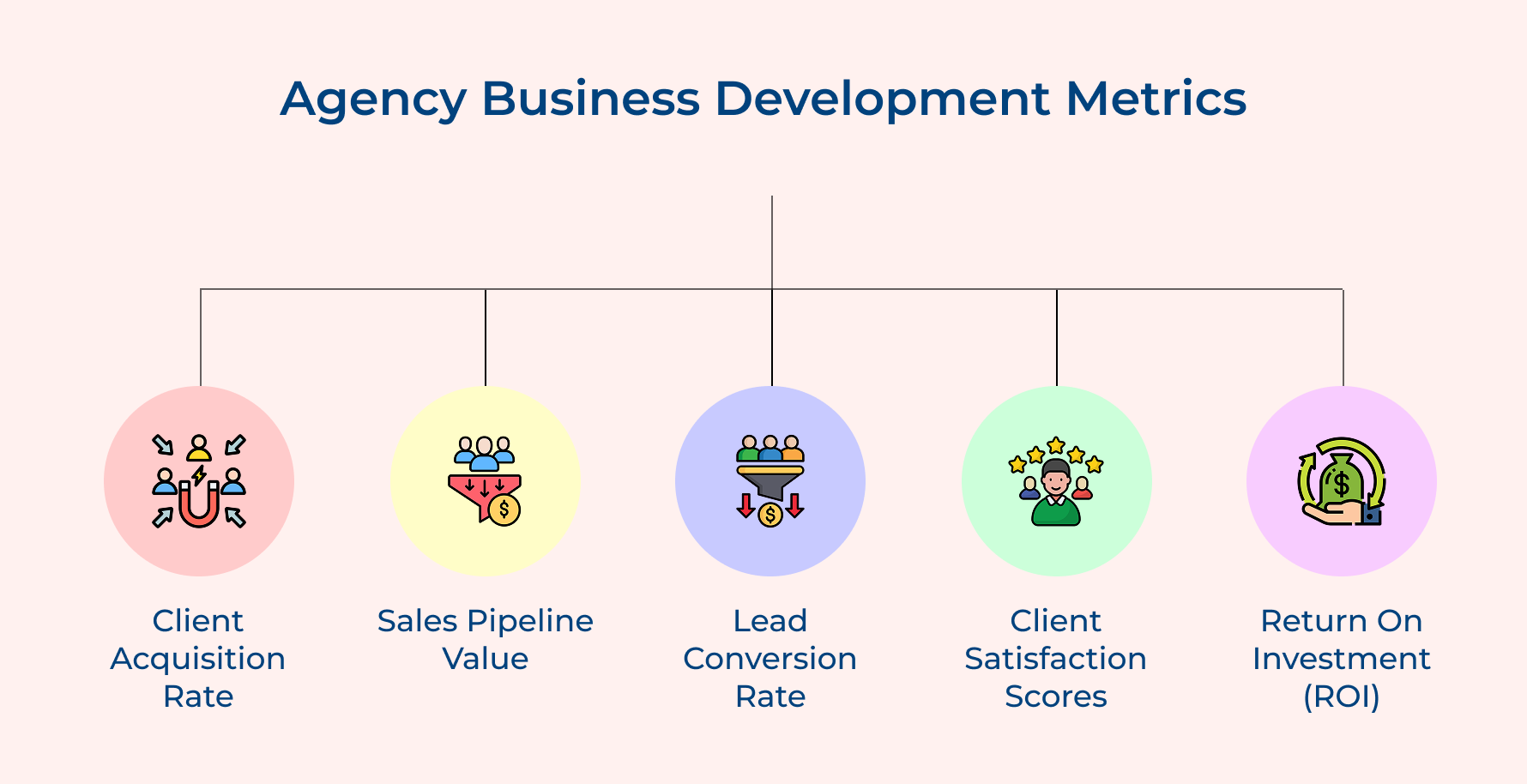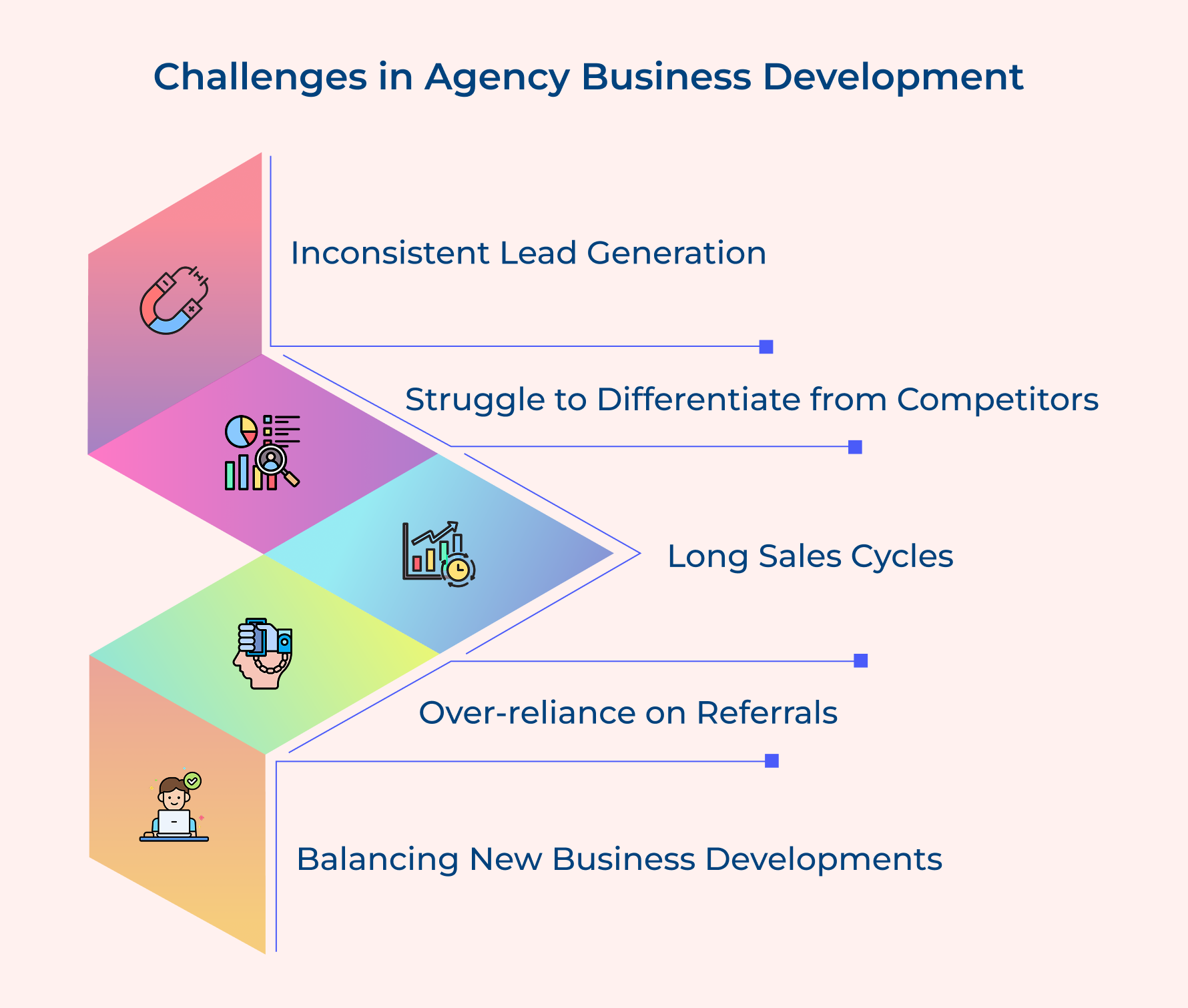10 Strategies for Boosting Your Agency Business Development
- What is Agency Business Development?
- Benefits of Business Development for Agencies
- Core Components Driving Agency Business Growth
- How to Craft a Successful Business Development Strategy for Agencies?
- Metrics for Assessing Agency Business Development Success
- Challenges in Agency Business Development & Strategies to Prevent Them
- Key Takeaways for Successful Agency Business Development
- FAQs about Agency Business Development

Key Highlights
Facing stiff competition and unclear on how to attract clients? Without a solid business development plan, agencies risk feeling overwhelmed, which can lead to lost clients and declining revenue. The struggle to effectively engage potential clients can be frustrating.
A well-defined agency business development strategy offers a solution. A typical marketing agency is valued 5 to 10 times its annual revenue. What could be the reason?
The focus is ideally on identifying target markets, strengthening client relationships, and leveraging effective marketing techniques. Let’s explore how these strategies empower agencies to achieve sustainable growth and excel in a competitive environment.
What is Agency Business Development?
Agency business development refers to the systematic approach used by agencies (including professional services and consulting firms) to identify growth opportunities and attract new clients, all while enhancing existing relationships. It encompasses a range of activities, including market research, networking, and strategic planning, aimed at driving revenue as well as establishing a strong market presence.
Effective business development helps businesses sustain growth in a competitive market. It enables agencies to differentiate their services, adapt to evolving client needs, and ensure long-term success by building trust as well as credibility within the industry.
Key objectives:
- Expanding client base: Actively pursuing new clients to diversify revenue streams and lessen dependence on existing accounts.
- Increasing revenue: Implementing strategies such as upselling and cross-selling to enhance profitability as well as capture higher-value projects.
- Enhancing brand visibility: Boosting the agency’s market presence through targeted marketing initiatives, positioning it as a leader in its field.
Benefits of Business Development for Agencies
Increased revenue, enhanced client loyalty, and improved market visibility are some of the benefits that come over the top. Let’s explore what other benefits it has to offer.
- Enhanced Market Position
Effective business development strategies elevate an agency’s market standing. Winning high-profile clients and delivering great results helps agencies establish themselves as industry leaders. An improved market position attracts more lucrative opportunities and a competitive edge.
- Revenue Diversification
Business development efforts help agencies expand their service offerings and client base, leading to diversified revenue streams. Diversification allows agencies to weather market fluctuations and maintain financial stability even when certain sectors experience downturns.
- Networking Opportunities
Minority business enterprises can leverage networking events and industry gatherings. These opportunities help agencies connect with potential clients, partners, and influencers, leading to new collaborations as well as business prospects.
- Reinforced Agency Reputation
The right approach to business development initiatives enables agencies to build and reinforce their reputation as experts in their field. Consistent delivery of high-quality work, thought leadership content, and successful case studies all contribute to a strong industry presence.
- Increased Client Referrals
A robust business development strategy often leads to generating more referrals. Current clients who are satisfied with the agency become brand advocates, recommending to their network. Organic growth through word-of-mouth tends to result in higher-quality leads.
- Talent Attraction and Retention
Successful business development creates exciting opportunities and challenges for employees, making the agency an attractive workplace for top talent. A growing agency with diverse clients and projects offers more career growth prospects as well as job satisfaction.
Core Components Driving Agency Business Growth
Discover the essential elements that fuel agency growth, focusing on client relationships, market positioning, and effective communication strategies. Here are the key components.
- Strategic Planning
Strategic planning involves setting long-term goals and objectives for the agency, identifying growth opportunities, as well as developing actionable plans to achieve them. It requires a deep understanding of the agency’s strengths, weaknesses, and market position. Effective strategic planning aligns all aspects of the agency’s operations with its vision for success.
- Client Relationship Management
Client relationship management focuses on nurturing strong, mutually beneficial relationships with existing clients. Regular communication, understanding client needs, delivering high-quality work, and proactively offering solutions are key aspects. Strong client relationships lead to increased loyalty, repeat business, referrals, and opportunities for expanding services, driving sustainable growth for the agency.
- Market Research and Analysis
Market analysis involves gathering, interpreting, and leveraging data about industry trends, client needs, along competitor activities. The process helps agencies identify new opportunities, anticipate market shifts, and make informed decisions. Staying attuned to market dynamics allows agencies to adapt their strategies to meet evolving client demands.
- Brand Development and Positioning
Brand development and positioning encompass creating a distinct identity for the agency while communicating its unique value proposition to the target audience. Crafting a compelling brand story, visual identity, and messaging that resonate with potential clients are essential components. A strong, well-positioned brand helps differentiate the agency, attract ideal clients, and command premium rates in the market.
- Financial Management
Financial management involves effectively planning, organizing, controlling, and monitoring the agency’s financial resources. Sound financial management ensures the agency has the resources to fund growth initiatives, weather economic fluctuations, and maintain profitability while scaling operations as well as pursuing new opportunities.
- Operational Efficiency
Operational efficiency focuses on optimizing internal processes, workflows, and resource allocation to maximize productivity. The core components usually include streamlining project management, leveraging technology, and continuously improving delivery methods. Enhanced operational efficiency allows agencies to handle increased workloads, improve profit margins, and deliver consistent quality as they grow.
How to Craft a Successful Business Development Strategy for Agencies?
A strong business development strategy helps agencies to grow and succeed. Here are the key steps to develop a tailored approach that aligns with the agency’s goals and market needs.
1. Set Clear Goals
Setting clear goals provides direction to business development efforts. It aligns your team, focuses resources, and creates a benchmark for measuring success. Without clear goals, your strategy lacks focus and efforts may be scattered.
Use your goals to guide decision-making, resource allocation, and performance evaluation. They serve as a roadmap for your business development activities, helping prioritize initiatives and track progress. Clear goals also motivate the team and provide a sense of achievement when met.
Tips:
- Make goals SMART (Specific, Measurable, Achievable, Relevant, Time-bound) to ensure clarity and accountability.
- Align business development goals with overall company objectives to ensure coherent growth.
- Involve key stakeholders in goal-setting to gain buy-in and diverse perspectives.
2. Conduct Market Research
Gathering insights into the industry as well as competitors helps you find opportunities. You also understand market trends to make informed decisions. Improper research risks developing strategies based on assumptions rather than facts.
Leverage market research to inform your targeting strategy, refine service offerings, and identify gaps in the market. It helps in understanding client needs, predicting industry trends, and staying ahead of competitors. Market research also aids in risk assessment and opportunity identification.
Best practices:
- Combine quantitative and qualitative research methods for a comprehensive understanding of the market.
- Regularly update your research to stay current with rapidly changing market conditions.
- Utilize both primary (direct) and secondary (existing) sources of information for a well-rounded perspective.
3. Identify Target Clients
Recognizing target clients focuses your business development efforts on the most promising prospects. It assists in tailoring the message, allocating resources efficiently, and increasing the chances of success.
The target client profile helps in guiding marketing efforts, sales approach, and service development. It also creates more relevant and appealing offerings, crafts targeted marketing messages, as well as prioritizes leads. A clear target also aids in developing a more effective value proposition.
Pro tips:
- Develop detailed buyer personas that include demographic, psychographic, and behavioral characteristics.
- Regularly update target client profiles based on market changes and business performance.
- Use data from your current best clients to inform target client profiles.
4. Develop a Unique Value Proposition
A unique value proposition (UVP) differentiates your agency from competitors and communicates benefits to potential clients. It’s essential for standing out in a crowded market and attracting the right clients.
Your UVP should be central to all the marketing and sales efforts. Use it to craft compelling marketing messages, guide sales pitches, and inform service development. A strong UVP doesn’t just gather attention but makes potential clients quickly understand why they should choose your agency over others.
Tips:
- Focus on the unique benefits you offer, not just the features.
- Ensure UVP is clear, concise, and easily understood by your target audience.
- Regularly test UVP based on client feedback and market response.
5. Create a Lead Generation Plan
A lead generation plan ensures a steady flow of potential clients into the sales funnel. It’s crucial for sustainable growth and helps you proactively seek out new business opportunities as well as consider business expansion.
A right lead generation plan helps build an online presence through search engines and social media. It helps in reaching your target audience more efficiently while ensuring a consistent approach to attracting new prospects.
Best practices:
- Diversify your lead generation tactics to reach prospects at different stages of the buyer’s journey.
- Implement a lead scoring system to prioritize and nurture leads effectively.
- Regularly analyze the performance of different lead sources and adjust your strategy accordingly.
6. Build a Structured Sales Process
A structured sales process provides a consistent, repeatable approach to converting leads into clients. It improves efficiency, enables better forecasting, and ensures a professional experience for potential clients.
Leveraging it helps in qualifying leads, preparing proposals, handling objections, and closing deals. A well-defined process also makes it easier to identify bottlenecks as well as areas for improvement in your sales efforts.
Tips:
- Clearly define each stage of the sales process and the actions required to move to the next stage.
- Use CRM software to track and manage leads through the sales process.
- Regularly train your team on the sales process and best practices for each stage.
7. Monitor Key Performance Indicators (KPIs)
Monitoring KPIs helps track progress toward goals, identify areas for improvement, and make data-driven decisions. It provides objective measures of business development success.
Use KPIs to evaluate the performance of your business development efforts, guide resource allocation, and inform strategy adjustments. Regular KPI monitoring helps you identify trends, celebrate successes, and address issues promptly. It also provides valuable data for reporting to stakeholders.
Tips to consider:
- Choose a mix of leading and lagging indicators to get a comprehensive view of performance.
- Set up dashboards for easy visualization and real-time monitoring of key metrics.
- Regularly review KPIs with your team to ensure alignment and drive continuous improvement.
8. Solicit Feedback and Adapt
Soliciting feedback and adapting strategy ensures your business development efforts remain effective. It helps in staying aligned with client needs, market trends, and internal capabilities. This way, the agency gets to avoid becoming outdated or ineffective over time.
Refine your services, improve the sales process, and enhance client satisfaction from the client feedback. It can inform updates to your value proposition, target client profiles, as well as overall strategy. Regular adaptation based on feedback helps stay agile and responsive to changing market conditions.
Pro tips:
- Implement formal feedback mechanisms like surveys and interviews, as well as informal channels for ongoing input.
- Create a culture of continuous improvement where feedback is valued and acted upon.
- Regularly schedule strategy review sessions to assess feedback and make necessary adjustments.
Metrics for Assessing Agency Business Development Success
Identify crucial metrics to evaluate your agency’s business development efforts, enabling informed decisions for continuous growth. Here are the metrics.
1. Client Acquisition Rate
The client acquisition rate measures the number of new clients an agency gains over a specific period. It indicates the effectiveness of the agency’s business development efforts in attracting new business. A higher acquisition rate suggests successful outreach and sales strategies. Agencies should track this metric monthly or quarterly to identify trends and adjust strategies accordingly.
2. Sales Pipeline Value
Sales pipeline value represents the total potential revenue from all active opportunities in the agency’s sales funnel. It provides insight into future revenue potential and the health of the business development process. Regularly monitoring this metric helps agencies forecast revenue, allocate resources effectively, and identify any gaps in the sales process that need attention.
3. Lead Conversion Rate
The lead conversion rate calculates the percentage of leads that turn into paying clients. It measures the efficiency of the agency’s sales process as well as the quality of leads generated. A higher conversion rate indicates effective lead nurturing and sales tactics. Agencies should analyze this metric to optimize their sales funnel and improve the quality of leads they pursue.
4. Client Satisfaction Scores
Client satisfaction scores, often measured through surveys or Net Promoter Score (NPS), gauge the overall happiness and loyalty of clients. High satisfaction scores correlate with client retention, upselling opportunities, and positive word-of-mouth referrals. Regular assessment of these scores helps agencies identify areas for improvement in their service delivery and client relationships.
5. Return on Investment (ROI)
ROI measures the profitability of business development activities by comparing the costs incurred to the revenue generated. It helps agencies determine which initiatives are most effective and worthy of continued investment. Calculating ROI for different business development strategies allows agencies to allocate resources more efficiently and focus on high-impact activities that drive growth.
Challenges in Agency Business Development & Strategies to Prevent Them
Examine common challenges agencies face in business development and discover proactive strategies to overcome them for sustainable success. Here are the strategies.
1. Inconsistent Lead Generation
Many agencies struggle to maintain a steady flow of quality leads, resulting in feast-or-famine cycles that can destabilize the business.
Prevention Strategies:
- Implement a diverse, multi-channel lead generation strategy to reduce reliance on any single source.
- Invest in marketing automation tools to maintain regular touchpoints with prospects.
2. Struggle to Differentiate from Competitors
In a crowded market, agencies often struggle to stand out, leading to commoditization and price-based competition.
Prevention Strategies:
- Develop a strong, unique value proposition that communicates your agency’s strengths and specialties.
- Showcase case studies and client success stories that demonstrate your unique approach as well as results.
3. Long Sales Cycles
Agency services often involve complex, high-value deals with multiple decision-makers, leading to protracted sales cycles that can strain resources.
Prevention Strategies:
- Implement a structured sales process with clear stages and timelines to manage expectations. Use lead scoring to prioritize high-potential opportunities.
- Develop targeted content for each stage of the buyer’s journey to nurture leads more efficiently.
4. Over-reliance on Referrals
While referrals are valuable, overreliance leads to unpredictable growth and limits expansion into new markets or services.
Prevention Strategies:
- Develop a proactive outbound sales strategy to complement inbound and referral-based leads. Invest in digital marketing and SEO to attract clients beyond your network.
- Attend industry events and conferences to expand your reach as well as build new relationships.
5. Balancing New Business Developments
Agencies often struggle to allocate time and resources between serving existing clients while pursuing new business opportunities.
Prevention Strategies:
- Designate specific team members or roles focused on business development to ensure consistent attention.
- Implement efficient project management processes to free up time for business development activities. Use client satisfaction metrics to identify at-risk accounts early and prevent churn.
Key Takeaways for Successful Agency Business Development
Effective business development serves as a cornerstone for agency growth, driving client acquisition and increasing revenue. Strategically identifying target markets and building strong relationships allows agencies to expand their client base as well as enhance brand visibility.
Business development initiatives facilitate adaptation to market changes, ensuring competitiveness. A focus on client retention encourages loyalty, contributing to long-term success. A robust business development strategy empowers agencies to navigate challenges, seize opportunities, and achieve sustainable growth in a dynamic environment, positioning them for lasting success in their industry.
Limit time — not creativity
Everything you need for customer support, marketing & sales.
Neeti Singh is a passionate content writer at Kooper, where he transforms complex concepts into clear, engaging and actionable content. With a keen eye for detail and a love for technology, Tushar Joshi crafts blog posts, guides and articles that help readers navigate the fast-evolving world of software solutions.
